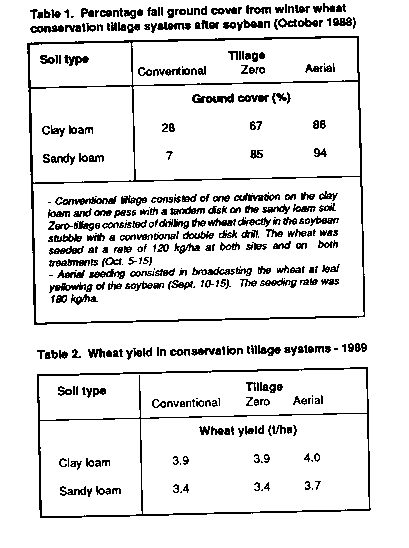
Sustainable Farming Index | Virtual Library | Magazine Rack
Search
| Ecological Solutions Roundtable
by Anne Weill
In eastern Canada, a lot of emphasis has been placed on reduced tillage and zero-tillage as a mean of reducing soil erosion. Unfortunately, it is often necessary to increase herbicide applications especially for row crops as mechanical weeding (including the action of plowing) is decreased. Such a problem is of less importance for winter wheat because it has a good competitive ability and is generally grown without herbicide use.
Winter wheat is not tillage responsive and therefore provides a low risk opportunity to try to reduce the amount of tillage. Two popular systems are being used by farmers to establish wheat in no-tillage systems: 1. plant into soybean residue with a conventional double disk drill in October; 2. aerial seed winter wheat at leaf yellowing in soybeans in early to mid September. The results of an experiment conducted by REAP-Canada in 1988-1989 showed these systems increase fall ground cover and cause no yield reduction when compared to conventionally tilled wheat (Table 1 and 2).

Other experiments done in Ontario showed that it is the type of rotation rather than tillage which affects wheat yield (Dr. T. Vyn, University of Guelph, Tables 3).
In this experiment, minimum tillage consisted of one pass with a tandem disk while conventional tillage consisted of moldboard plowing plus 1 or 2 passes with a tandem disk.
The results of this experiment and others suggest that wheat yield is reduced by minimum and zero tillage when the previous crop is a cereal. However, there is no negative effect on yield when no-tillage was used to establish wheat following soybeans. In the experiment nitrogen was applied at a rate of 100 kg/ha using a 28% N solution in late April.
To evaluate a more sustainable winter wheat production system, an experiment was established to see if winter wheat could be grown without N fertilizer. Manure and fertilizer treatments were imposed on the different tillage treatments described earlier (REAP experiment -conventional, zero-till and aerial systems). For each tillage system, two levels of compost (CL: 7.5 t/ha and CH: 15 t/ha), two levels of liquid swine manure (ML: 40 0001/ha and MH: 80 000 I/ha), two levels of fertilizer (FL: 50 kg/ha and FH: 100 kg/ ha) and a control were tested. All manures and fertilizers were applied in late April and left on the soil surface. Spring liquid manure application is possible in dry springs and is made easier by conservation tillage because the larger amount of residue provides better field support. Risks from runoff of the liquid manure are also greatly reduced in the no-till systems as very high ground cover is present and infiltration is high when the liquid manure is applied. If an irrigation system is used, manure can be applied even in wet springs.
For the fertilizer treatments, there was no wheat response to nitrogen above 50 kg/ha. Good yields were obtained when liquid swine manure was used. Compost had no effects on final yields or leaf tissue analysis (not shown). The liquid manure infiltrated in the soil immediately after application while compost stayed on the soil surface which probably resulted in a fairly low amount of nitrogen available to the plants.

The use of manure combined with conservation tillage seems to be a promising technique. However, one has to remember that it is a technique which can be used only when the climatic conditions are favorable unless an irrigation system is available.
Copyright © 1990 REAP Canada
Reprinted with permission. All rights reserved.
Info Request | Services | Become EAP Member | Site Map
Give us your comments about the EAP site
Ecological Agriculture Projects, McGill University (Macdonald
Campus),
Ste-Anne-de-Bellevue, QC, H9X 3V9 Canada
Telephone:
(514)-398-7771
Fax:
(514)-398-7621
Email: info@eap.mcgill.ca
To report problems or otherwise comment on the structure of this site, send mail to the Webmaster